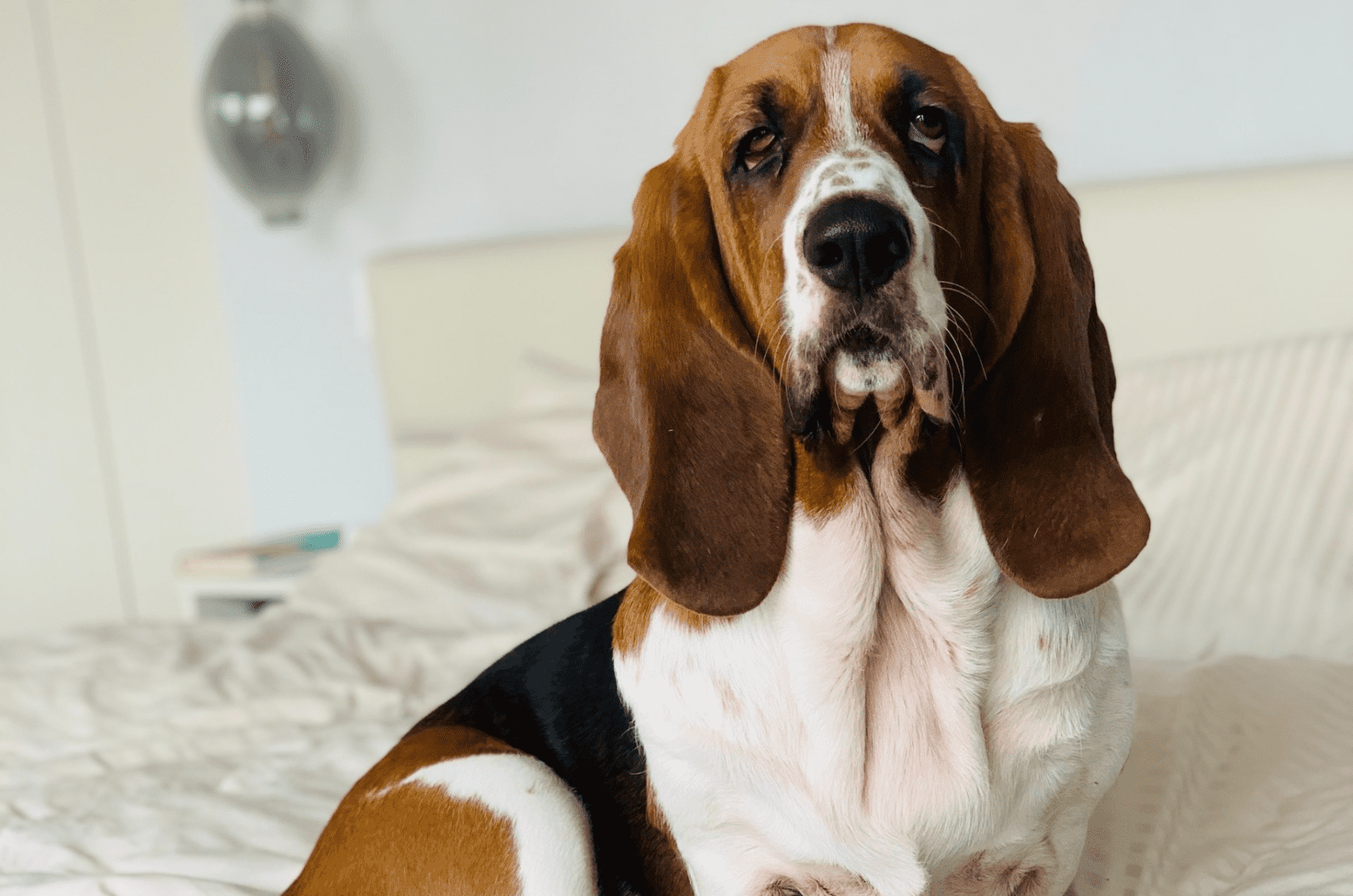The Basset Hound, once a favorite hunting dog among many, now a dear and darling pet for many pet owners, but how big do they get? That’s what the Basset Hound growth chart is there for.
The Basset Hound growth chart is a tool that helps dog owners both new and veteran to learn about their furry friend and how he physically changes throughout his life.
It’s a great guideline, a reference point that they can turn to when needed to help determine whether their dog is packing on the pounds, slightly too skinny or if he’s well within the healthy range for his age.
It may seem silly, but it can be a lifesaver, especially during your dog’s puppy period where proper weight management and dieting are important to have a healthy adult doggo on your hands.
Naturally, this growth isn’t the same in every representative of the breed and your dog is no exception to the rule.
Things like the dog’s overall health, the amount of exercise and even the genes themselves can determine what route your dog’s journey takes.
It’s up to you to patch up any potholes along the way as best you can so your precious pooch can live a long and happy life.
However, don’t be shy about asking a vet questions related to these growth and weight charts and your dog in particular as they’ll be the most likely to know what looks like okay weight for your doggo and what seems under or overfed .
So, read on to find out what this chart looks like as well as find out what it is that changes the standard growth average so much and why, and some of the more commonly asked questions about Basset hounds.
The Basset Hound Growth Chart
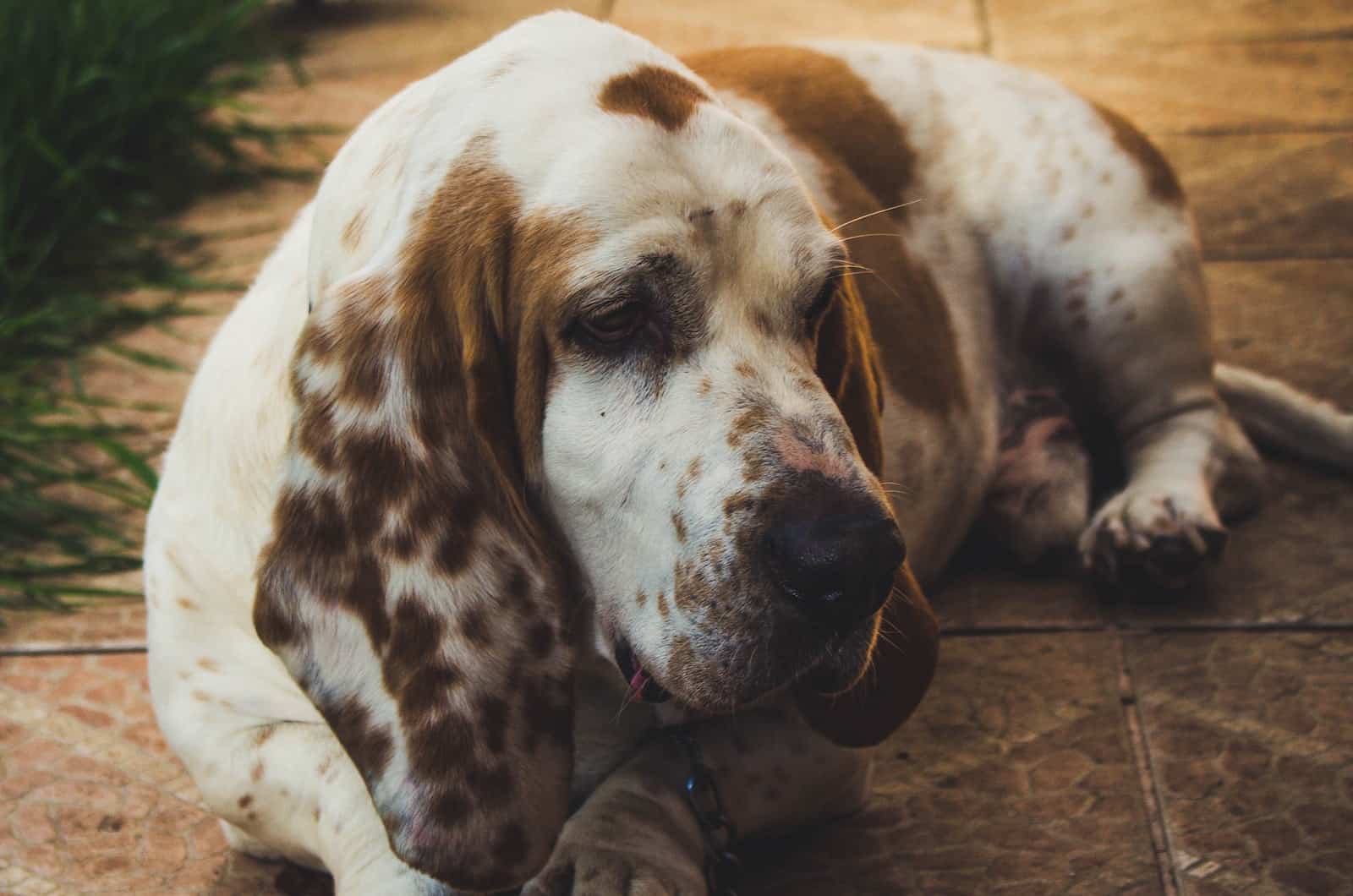
[table id=661 /]
As you can see here, the progress with the Basset’s weight is somewhat hectic at the start, but the monthly increments start to gradually fall off after the 6th month or so, give or take a few weeks.
These dogs start off at only a few ounces of weight at birth and eventually reach around 70 pounds by the end of their puppy period.
After that there aren’t too many fluctuations that occur afterwards aside from any abnormalities in your pooch’s health or dietary changes.
Though, at a mere 15 inch height, one may find themselves dumbfounded as to where all this weight goes to.
But, as we all know, these dogs are relatively long, going from 26 to a respectable 35 inches in length in some Basset Hounds which is where all of these 70 pounds are distributed to in the first place and gives them their unique appearance.
However, this does come with its own challenges which is also why obesity is a big threat to a pooch of this particular shape, but more on that later.
Basset Hound Growth Throughout The Years
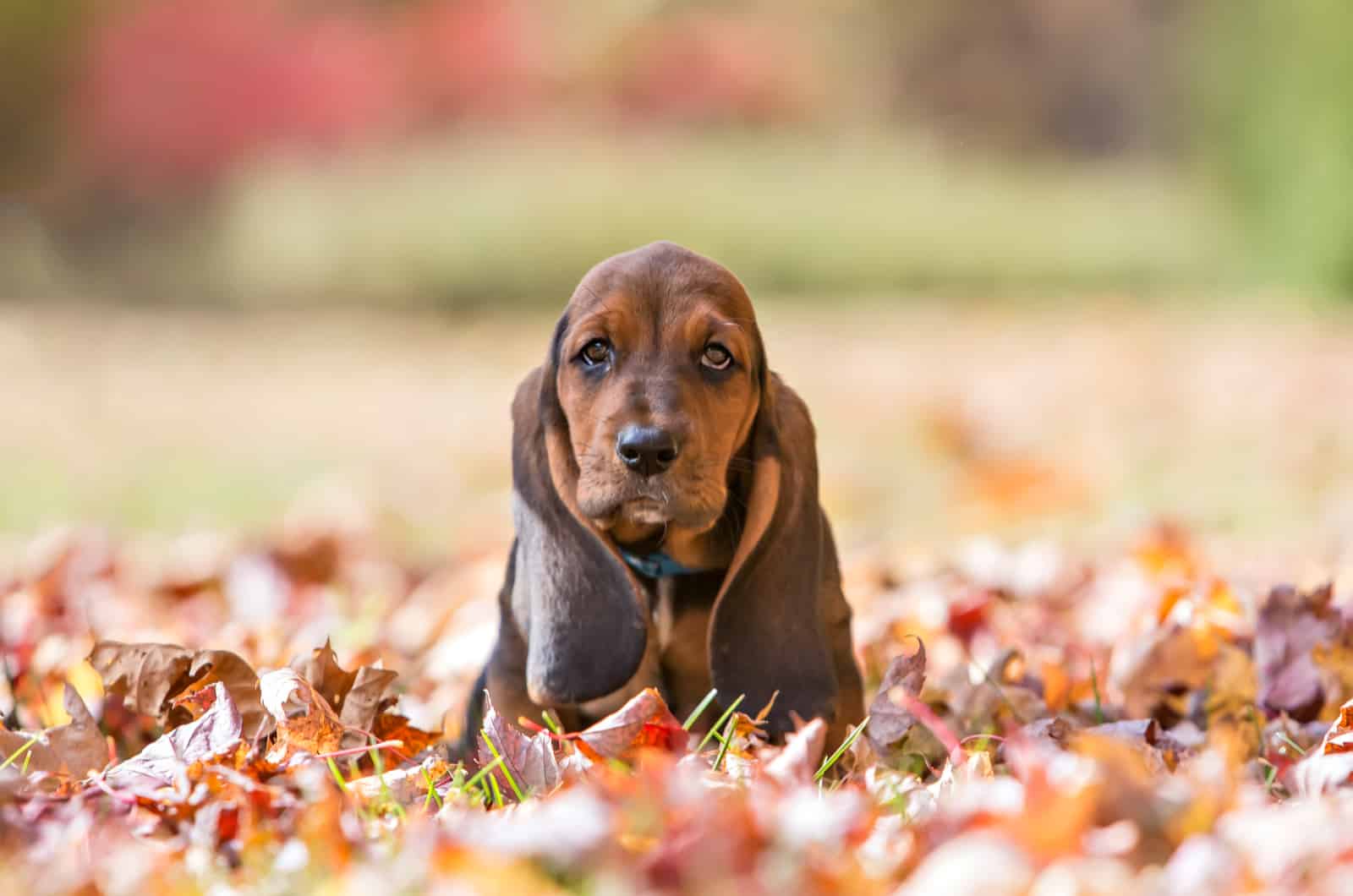
With the puppy weight chart laid out, I figure it’s worth going into a little bit more detail about what exactly happens during this period when your doggo is still young.
The somewhat drastic changes in his lifestyle that occur in such a brief window of time.
0-2 Weeks Of Age
This is the stage that every dog goes through, having just been born, weighing barely a few ounces and unable to really do much of anything aside from cling to his mother.
She is his caretaker for these first two weeks, a source of safety, comfort and nourishment.
Your job, or the breeder’s job in this case, is to keep the mother fed so she can keep her strength up while providing for her entire litter too.
You don’t want any of them to go malnourished after all, which is why some breeders simply allow the mother to free feed, but others advise against it.
In rare circumstances, a mother may reject one of her pups for one reason or another. Should this happen, you’re going to need to take the caretaking role a bit sooner than you may have anticipated.
You’ll need to get a heating pad ready to simulate the warmth of their dear mother, a bottle and a replacement for the mother’s milk and nutrients from the colostrum to give the pup the requirements needed to facilitate his further growth.
However, you may still find your Basset Hound pup being a little restless at night, unable to get any sleep because he doesn’t have a familiar noise to fall asleep to which may scare him.
Given how much time they’re being carried around before being born, the pups get used to the rhythm of their mother’s heartbeat. It helps calm them down. But, if their mother refuses to take them in, an old analog or alarm clock can do the trick.
Place it underneath the pad and your pupper will most likely simmer down and hopefully get a good night’s sleep.
3-8 Weeks Of Age
At the start of this stage, your doggo would’ve finally become able to walk somewhat properly on his own two legs and would’ve gained the ability to see, allowing him to explore his imminent surroundings a bit better.
He may end up tripping on his own long ears from time to time though, but that shouldn’t discourage him much as he’s still learning a lot.
He’ll also be going through a good number of growth spurts mentioned earlier, length and height wise, and this is just their beginning.
With all of these changes, it’ll be time to start training him, be it regarding his behavior, his leash etiquette or simply to start socialization early by letting him hang around other dogs or even kids, albeit the kid part is done after he’s rehomed usually.
Other than that, it’s also time to start getting him off his reliance on his mother and her milk and swap him over to dry dog food for puppies, one that’s more calorie intense so your dog can keep up with his rampant growth.
This sounds a lot simpler than it is, and it can be if you don’t use the method that most other breeders and dog owners have used for ages, the process of gradual introduction.
You mix in one part kibble with 3 parts water or milk to mask the new addition and have him slowly adapt to it, making it softer and easier to chew and swallow in the process.
After that, you’ll gradually keep adding more of the kibble in while reducing the amount of liquid present until it ends up being just pure dog food.
You’d be surprised just how well this ends up working, and it’s a trick that works well on pickier eaters later on in life too should you want to swap from one dog food brand to another.
By the time week 8 rolls around, the dog should’ve at least mastered the basics of his training in order to be rehomed to the designated buyer after getting his vaccinations in and his deworming treatment done..
8-12 Weeks Of Age

These four weeks are the initial adaptation period for the dog at his new home. The first one may be somewhat difficult as the dog is likely to miss his mom and littermates a ton, but he should grow out of it relatively quickly.
The rest of the time is normally spent interacting with him and continuing the training that the breeder had already begun with him.
This is also where proper socialization around children can begin too, though the Basset Hound is already an extremely relaxed and well adjusted dog in regards to company, especially kids and other dogs.
It doesn’t have to be as intense as it might need to be with other dog breeds, but a little bit will still help cement that already friendly behavior.
4-9 Months Of Age
By the start of this period in his life, your doggo would’ve gained almost half of the intended end weight of which the gap will mostly fill up by the end of month 9.
That said, around month 5 or 6, the weight gain will show a significant drop in gains, though it’ll still be going up.
10-18 Months Of Age
The final period before adulthood. It’s the time where your dog is going to finish most of his growth and any further increases in weight or height will be miniscule.
When this period finishes is flexible however.
A good portion of Basset Hounds fall under the 16 to 18 month range in regards to reaching their adult weight and transitioning to adulthood, while some more extreme cases need the full 2 years to cap it all off.
Don’t worry, it’s no anomaly either and it shouldn’t be a cause for concern unless your dog falls severely under the estimated growth for the month, in which case a call to the vet is going to be necessary.
Other than that, it’s time to welcome your good boy into adulthood.
Adult Years (1-7 Years Of Age)
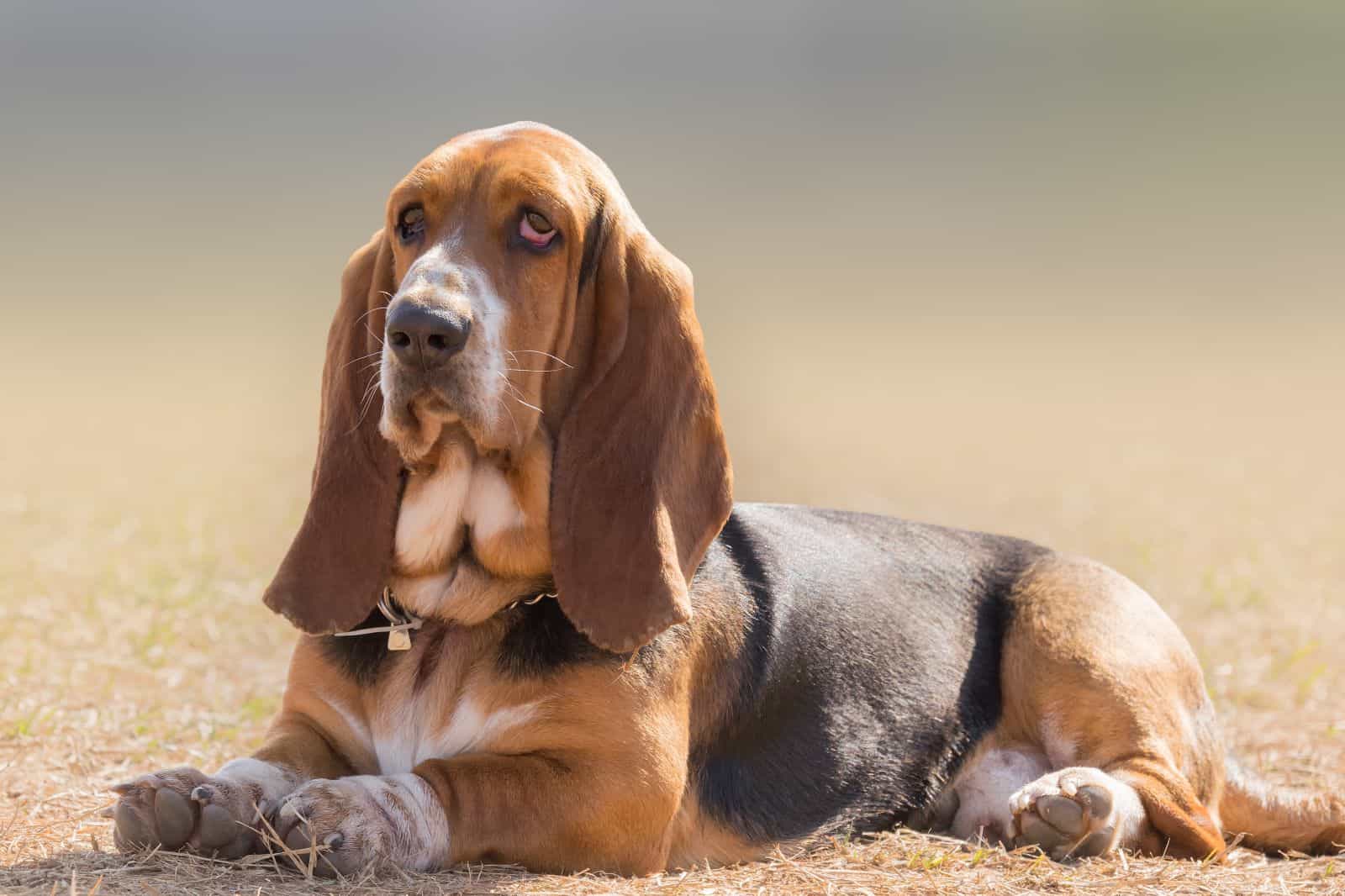
The adult period isn’t as hectic as the puppy one was.
It’s the time where you finally get to take a bit of a breather in having to worry about reaching proper growth goals and the like and have more time to enjoy life with your canine companion.
His feeding habits should remain the same, though you should transition him from puppy kibble to adult dog food as it’s less caloric and contains a balanced amount of nutrients.
The amount of food that you’re feeding him will start to slowly decrease in quantity as the years go by, though this will only start happening somewhere around the 3 to 4 year mark as he starts his journey to seniority and his metabolism starts to slow down too.
His growth curve will remain stagnant for the most part too as he has long since reached his full size.
The Senior Years (7+ Years And Onward)
The senior years are pretty similar to the dog’s adult ones, apart from eating less and being more prone to various health problems.
A good number of dogs swap from the adult kibble to brands more oriented toward senior dogs, but it’s not mandatory for the most part.
The amount of daily meals and overall calories will continue to decrease proportional to the decrease in speed of his metabolism.
Other than that, he’ll still be your happy little doggo.
How Big Do Basset Hounds Get?
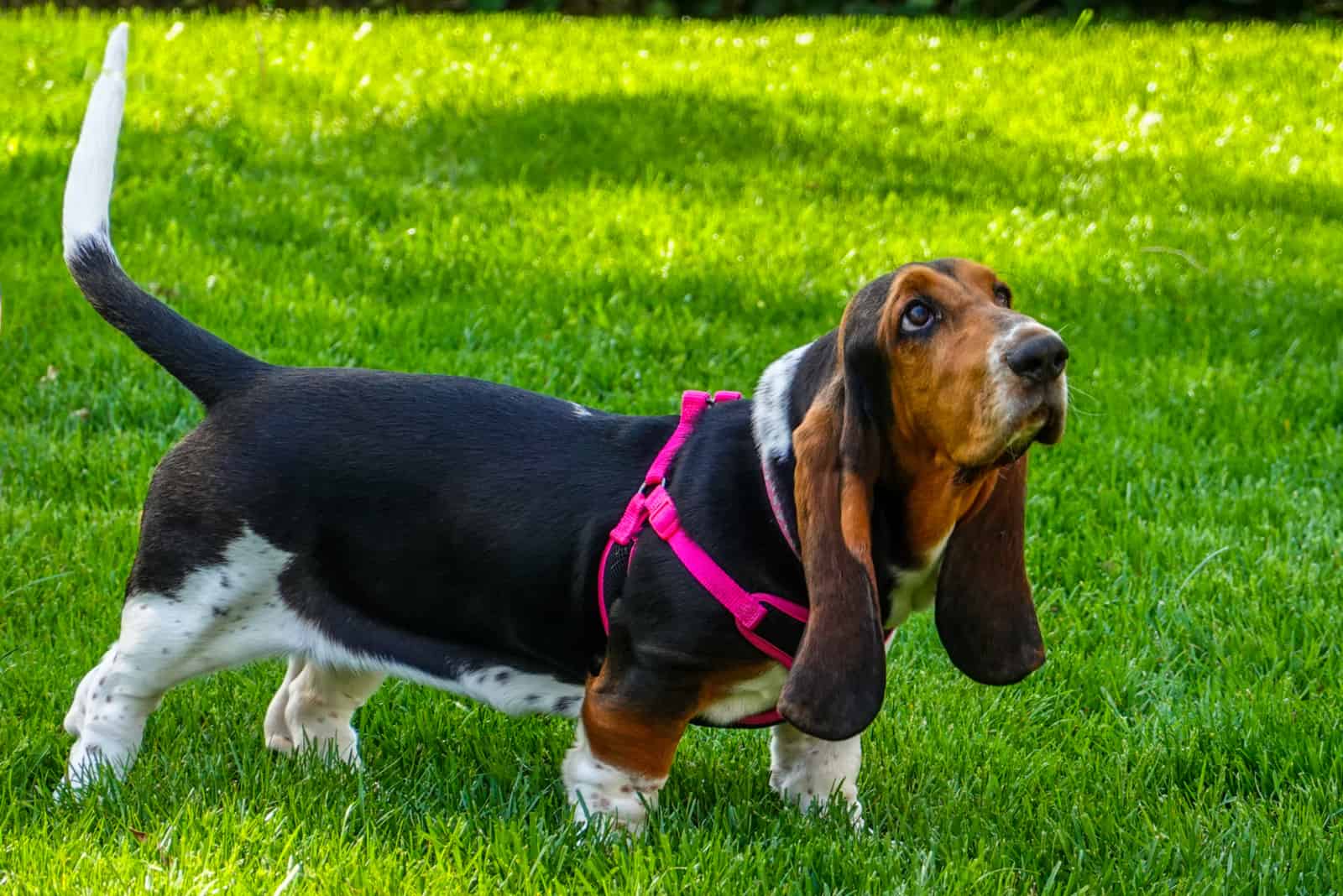
The Basset Hound’s height isn’t all that impressive. His average height comes in at around 15-ish inches, but what he lacks in height, he makes up in sheer length.
He has that traditional wiener dog shape as his length comes out to about 26 to 35 inches.
It’s the shape that he’s iconic for after all.
Dimensions aside, he also weighs a good bit because of it. The basset hound weighs somewhere around 70 pounds when looking at a healthy representative which classifies him as a medium-large dog, shockingly enough.
If you’re looking to find out if the weight of your Basset hound is equivalent to that of an adult, or if he has reached his maximum weight, you can always have a DNA test conducted and find the results out.
If you’d rather go down the traditional route, the average estimate of when a Basset Hound reaches adulthood is anywhere from 16 months to 2 years.
Although some consider him to have become an adult on his first birthday, that may be the case mentally, but the Basset usually finishes his physical growth around the aforementioned months.
What Elements Affect A Dog’s Growth?
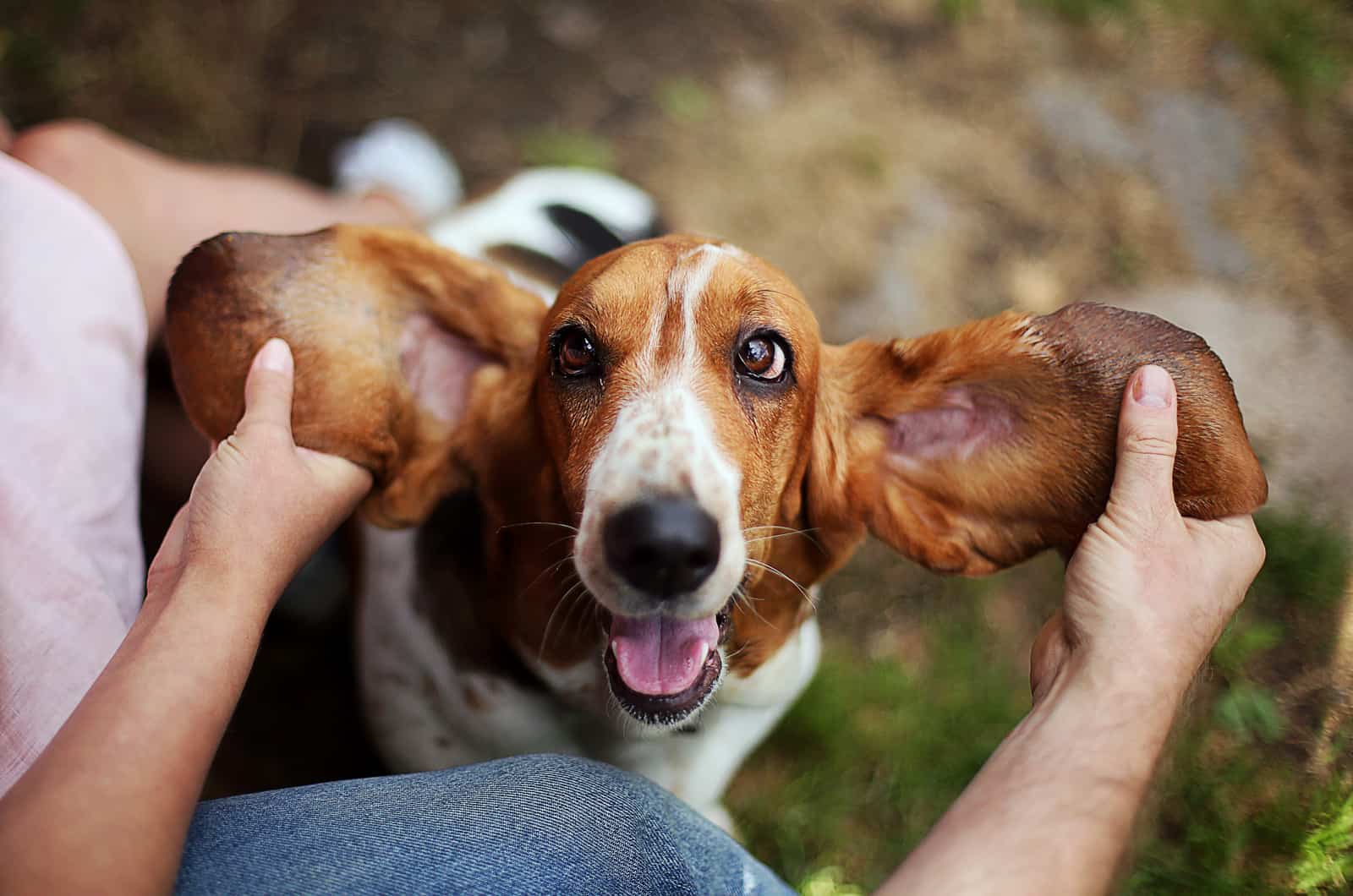
A dog’s growth is affected by a number of things, three of which are common for almost every canine companion.
I’ve mentioned them earlier, but it’s always worth going into a bit more detail so you can get further insight into these factors and possible options as to how to mitigate their negative effects.
They are:
The Genetics
The biggest contributor to anything that happens with the body, regardless of species.
It’s no different for dogs either as genes affect a dog’s size, coat color, overall strength of their immune system, intolerances, allergies and much more.
The building blocks of life which determine a creature’s potential stat growth.
For example if your Basset Hound was bred from two smaller Basset Hound parents, then he’s highly likely to come out as a small dog too.
It’s the lottery of life, one that everyone plays and some get dealt a better hand while some have very little to play with, but we all make the most of it.
Unfortunately, there’s very little we can do about the genes themselves for our furry friends, but we can help deal with the side effects through lifestyle and dietary changes for our dear pets until we find a version that fits them.
What He Eats
The main reason behind weight gain is eating high quantities of food, that much is a given fact.
It becomes even worse when the food is unhealthy which piles the pounds on and can easily lead a dog to obesity which, in a breed like the Basset Hound, is going to be hard to deal with given where his center of gravity is.
Back pain is only one of many problems that’ll sprout from that as is general lack of energy and will to exercise, a cruel cycle that feeds into itself, only making things worse.
Aside from that, it also leaves the body more prone to heart disease which can lead to disastrous consequences.
On the other side of the spectrum, we have the other extreme, not eating enough for whatever reason.
Malnourishment is equally as bad as obesity, if not worse as it leaves the body starved of the essential nutrients it needs to thrive and grow at a regular pace.
This is especially disastrous should it affect a dog who is still in the puppy stage and still growing as it can lead to a number of abnormalities which can lead to long term complications.
Though malnourishment will rarely ever pass by an experienced breeder, the more likely cause to this is going to be some sort of internal parasite which you should be on the lookout for as it also relates to the food he eats or finds on the ground.
The solution to this one is simple, dietary adjustment depending on his condition.
A few pounds here and there is fine, it only becomes a problem when it steers way too far in one direction or the other and needs course correction.
Reduce or increase his food intake depending on necessity and make sure that you’re not feeding him any contaminated food.
Manage that well and you’ll help keep his rate of growth on track and avoid him being over or underweight, and would instead reach the average weight of an Adult Basset Hound in no time.
Of course, one needs to know what a proper diet for a puppy is too.
It revolves around a few key ingredients that puppy food must have.
The first one is the main protein which will help build lean muscle mass and help support the dog’s skeleton better in response.
Speaking of bones, calcium and phosphorus are next on the list as they help pups strengthen their bones and keep their joints flexible.
DHA and EPA help boost cognitive function which is crucial in those early stages of their life.
The importance of digestion is paramount, especially when food is concerned, so you’ll want to find food that contains probiotics and prebiotic fiber to help digest food a lot easier and strengthen your pup’s gut flora.
Many people will also wonder about whether dry or wet dog food is better, and I can safely say that dry kibble wins out most of the time given its high nutrient content and not staining teeth unlike various wet foods.
The latter should be used as a reward or as a special occasion to treat your long boy every now and then while helping him maintain a healthy weight.
How Much He Exercises Daily
Given their nature as hunting dogs, Basset Hounds require a good amount of exercise to satisfy their daily needs.
Usually, about an hour of moderate exercise is adequate to keep his spirits up and to keep him healthy overall.
However, this amount can be reduced depending on the state of his health, if he has some underlying health issues that don’t allow him to go for the full hour and such.
In that case, you’re likely going to either switch to light activity, or have to adjust the diet accordingly until he recovers, if he does.
What About Spaying Or Neutering My Basset Hound? Will That Have Any Impact On His Growth?
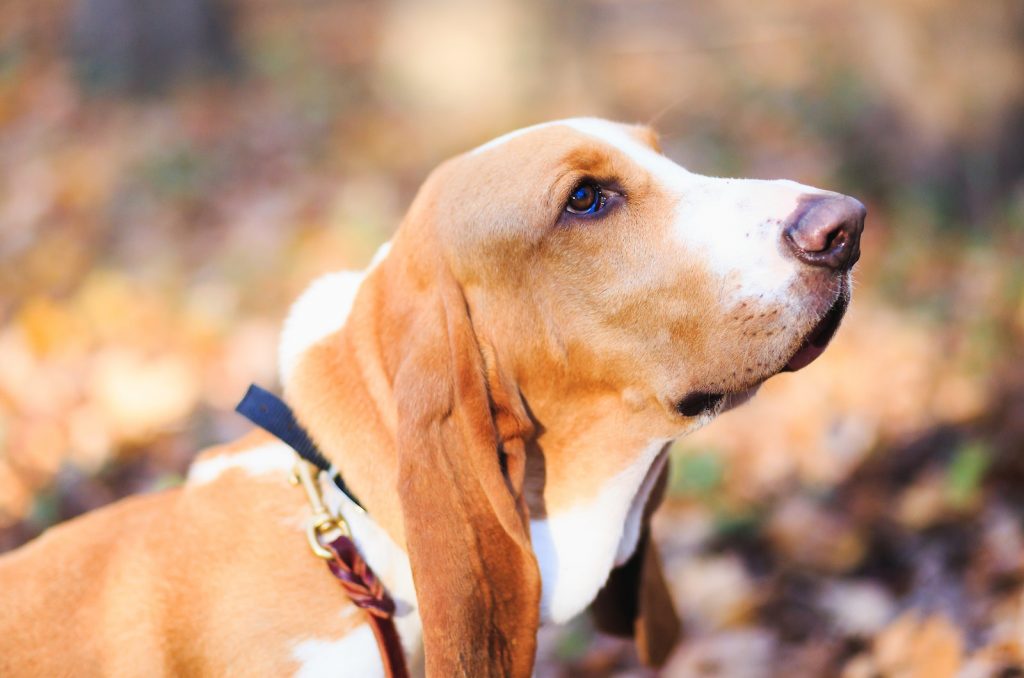
Surprisingly enough, going through the process of spaying or neutering your dog may have an effect on your dog’s overall growth if you do it too early.
The hormones from their reproductive organs fuel the dog’s growth plates, and if he hasn’t grown far enough, cutting off the supply of said hormones may lead to stunted growth, among other problems that that may incur.
While it will also help calm a relatively aggressive dog down, it can be a double edged sword as it makes dogs more prone to obesity and heart disease.
Do keep in mind that the decision for such a procedure should also be talked about with your dog’s vet before being performed to see if there are any other alternatives to it that can be explored or if it’s even the right time to do so.
FAQs
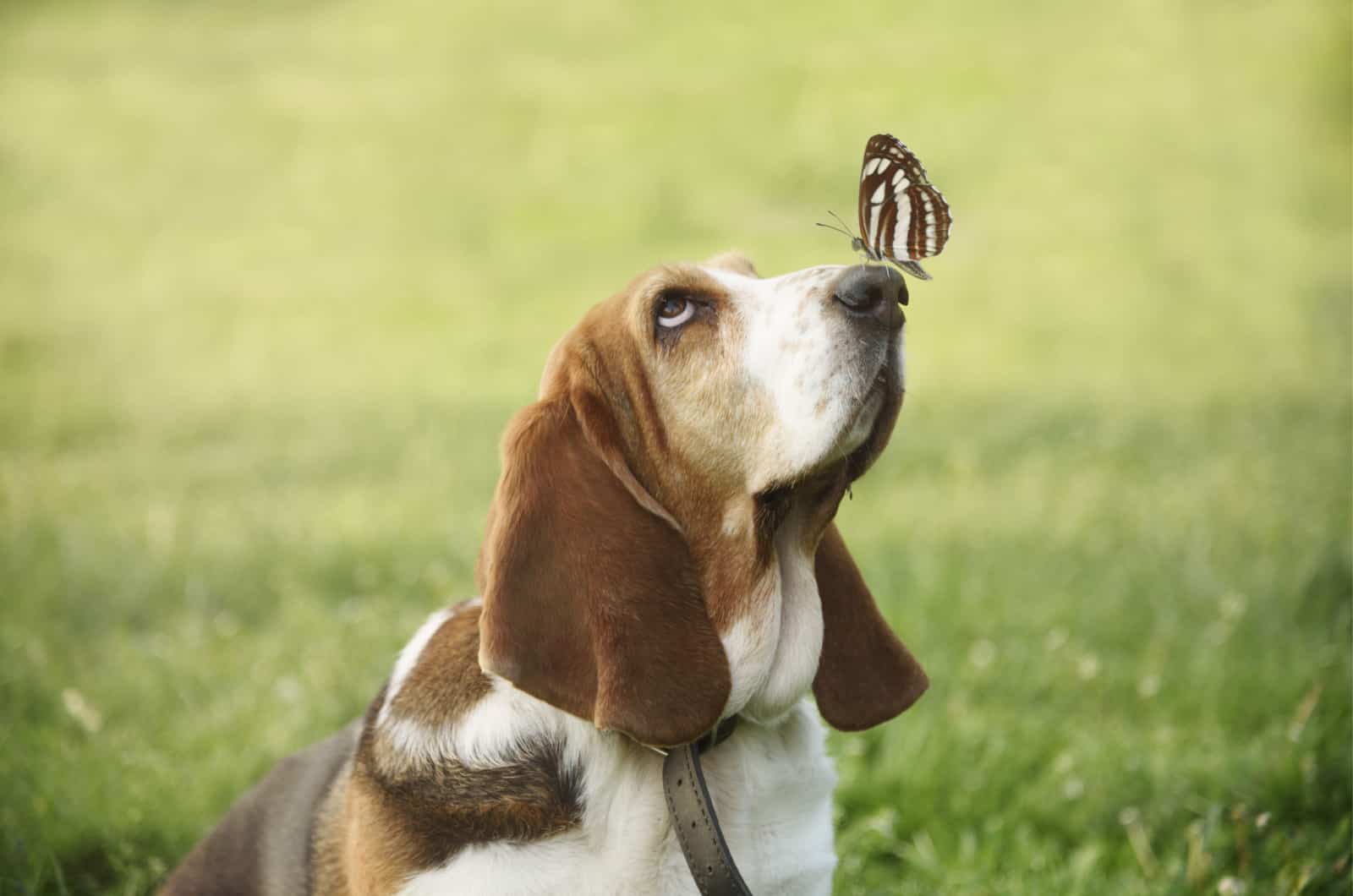
What’s The Average Lifespan Of A Basset Hound?
The average life expectancy of a Basset Hound is around 10-12 years, though it can move all the way up to 15 through proper care and good genes.
What Is The Breed Standard For The Basset Hound?
While the full breed standard is pretty massive, the AKC (American Kennel Club) describes the Basset Hound as a dog with short legs and heavy bones which make him fully equipped to handle rough terrain for the purposes of hunting.
A dog with an impeccable sense of smell unlike any other and one with intent in his movement.
And finally, a canine who’s temperate, steadfast and extremely loyal.
What Are Some Of The More Common Health Issues Regarding The Basset Hound?
While the Basset may be a delightful animal, he unfortunately suffers from a myriad of health issues that can make his life worse.
Thankfully, most of them can be remedied, but some will become progressively worse as they keep aging.
Here are some of the most common ones that this breed ends up having to deal with:
Joint And Bone Problems
To no surprise, the Basset Hound’s main issue relates to their bones and joints due to their elongated shape paired with their heavy weight.
Elbow and hip dysplasia are the most common occurrences as so much pressure is put on them to help keep the dog walking properly.
Following up after that, we have patellar luxation, a condition where the kneecap feels like it’s dislodged and starts moving out of position causing an uncomfortable and painful feeling in the affected area.
The final issue relates to carpal valgus, an issue with their wrists ending up bending to a side which
applies unneeded pressure on the joint and causes growing pain as the Basset gets on in years.
If you suspect any of these may have occurred, I suggest taking your dog to the vet to have him checked and discuss treatment options with the veterinarian in question to see if anything can be done about the problem.
Skin Issues
Basset Hounds are known to be affected by skin conditions due to how allergy prone they are, but the biggest culprit to their skin issues are yeast infections, one in particular that’s called Malassezia.
They’re most vulnerable around their ears given how long they are and how they tend to retain a lot of particles and debris from the air.
However, the aforementioned allergens also lead to general skin infections which is why including omega-3 and 6 fatty acids in your dog’s diet is of paramount importance for the Basset Hound to improve skin health.
Other than that, various topical creams and shampoos will help, but you’ll need to check with your dog’s vet to see which ones you’d need to buy depending on condition.
Bloat
The problem that plagues almost every dog breed, including the Basset Hound, is bloat.
It’s a condition that occurs when the stomach distends from eating too quickly or something similar and then contracts poorly, tangling itself up and trapping fluid, gas or food inside.
This also ends up cutting blood flow to several organs which can be life threatening if not resolved quickly and gets progressively worse the longer you wait.
Deep-chested dogs are more prone to this, but it can affect any dog, as was said earlier.
This is why the dog is taught to portion his food, chew it properly and eat slowly even when he’s a small pup, to minimize the risk of this particular condition happening in the first place.
Thankfully, it can be solved, but, if your dog hasn’t learned since then, try giving him more meals, but with less food in them.
This will help keep his digestion working without it being overloaded.
But, even with all of those precautions, it can still happen, so just be on the lookout for any signs of danger.
Intestinal Parasites
The main enemy of a dog’s growth and overall health are intestinal parasites, worms in particular with the most common being ringworms, hookworms and tapeworms.
Most of you know what these pests do, but for the uninitiated, they’re usually found in contaminated foods or any random junk your dog may end up ingesting.
They find their way into the dog’s digestion and then nestle themselves in.
After that, they start sapping nutrients from the food your dog ingests to feed themselves while causing problems for your canine companion as he isn’t getting the nutrients that his body so desperately needs.
This usually manifests itself as an overall lack of energy or lethargic behavior in your dog which can further progress into vomiting, diarrhea and nausea, as well as rapid weight loss.
The signs are usually apparent, but the consequences can be absolutely devastating, especially if this happens while your precious pooch is still in his puppy period as it could lead to stunted growth and further complications down the line.
This is the reason for the frequent deworming sessions that happen every other month when a dog is just a pup, even if the results of the feces test come up negative for worms. You can never be too careful.
What To Do If My Dog Is Severely Underweight Or Obese?
The extremes regarding weight are never fun to deal with for you or your dog as they can cause a great number of problems.
As we’ve seen just up above, malnourishment can lead to stunted growth and overall lack of development that can leave the immune system compromised.
This leaves your dog more prone to various illnesses and hampering his physical ability with poorly developed muscles or skeleton.
On the other hand, obesity affects the body in different, but equally poor ways.
Firstly, your canine companion will be more prone to heart problems, much like a human would if he was treading over the obesity line.
Secondly, his added weight would put even more strain on his spine and overall skeleton, making him more liable to the issues related to bones and joints mentioned above through added wear from said strain.
However, it’s also worth knowing what’s considered underweight and what’s considered obese.
The dog’s weight ranges displayed in the above chart for both female Basset Hounds and male Basset hounds are averages.
A few pounds below or over these ranges isn’t the worst thing, however, it’s a good warning sign that something needs to be done before it becomes a problem.
As a good measure, always try to stick close to the suggested weights and your dog should be okay.
This is done through simple means, changing his diet to something less fattening while still nutritious or simply including more exercise into the daily plan to help him work those calories off.
However, don’t overdo it with the whole exercise thing as a dog can only take so much before it becomes detrimental.
A good hour of moderate exercise is normal for the Basset Hound, but can be extended a little if
toned down a notch.
Aside from that, it’s also worth continuing with the deworming routine if needed just so that it doesn’t end up being the cause of his sudden unhealthy weight loss.
How Much Exercise Should My Basset Hound Get Per Day?
While Basset Hounds used to be primarily hunting dogs in the past, and still are, but to a largely lesser degree, they don’t really need that much exercise.
As mentioned before, an hour of moderate physical activity is often more than enough.
Said activity can be going out for a walk, playing with his toys or playing with you or the other dogs in the field.
You can go over that one hour mark by a few minutes, 10, maybe 20 max, but try to not over exert the poor guy.
How Much Does A Basset Hound Cost?
Bassets aren’t the most expensive dogs out there, thankfully, ranging as cheap as $450 and going all the way up to $1500 in some cases, though you’re more than likely to find them within the $750-$850 range, give or take a few bucks.
The biggest determining factor regarding price tends to be the purity of the breed.
However, there are more costs to consider other than the purchase.
The various visits to the vet for different procedures, the cost of the puppy dog food, the toys, collars, brushes, leashes and many other things that a dog may need for his first year of life.
This can rack up to a hefty sum, the first year alone can take around $2400 to $2600, though subsequent years tend to be cheaper once you’ve gotten everything sorted.
Why Is My Basset Hound So Small?
If the small size is related to his height alone, that’s normal for Bassets.
They’re small in height but pretty long length wise, to the point where they’re almost considered a large breed of dog.
However, if the issue is that he’s small in overall size, it could mean one of two things.
On one hand, your Basset Hound puppy could’ve come from smaller parents, ones who are genetically predisposed to not be as big as other dogs of their kind, and that gene could’ve been inherited by your dear little doggo.
If that’s the case, then there’s not much to worry about.
On the other hand, it could be due to some underlying health issue, malnourishment or intestinal worms being the most likely suspects, but it could also be something else.
It could’ve come from something that happened when he was a pup which caused this developmental defect.
Depending on when you spot this, it may or may not be remedied.
Whatever the case may be, I suggest taking him for a vet visit to get checked up and talking to your dog’s vet about it to see how serious the issue may be, and if anything can be done about it in the first place.
In Conclusion
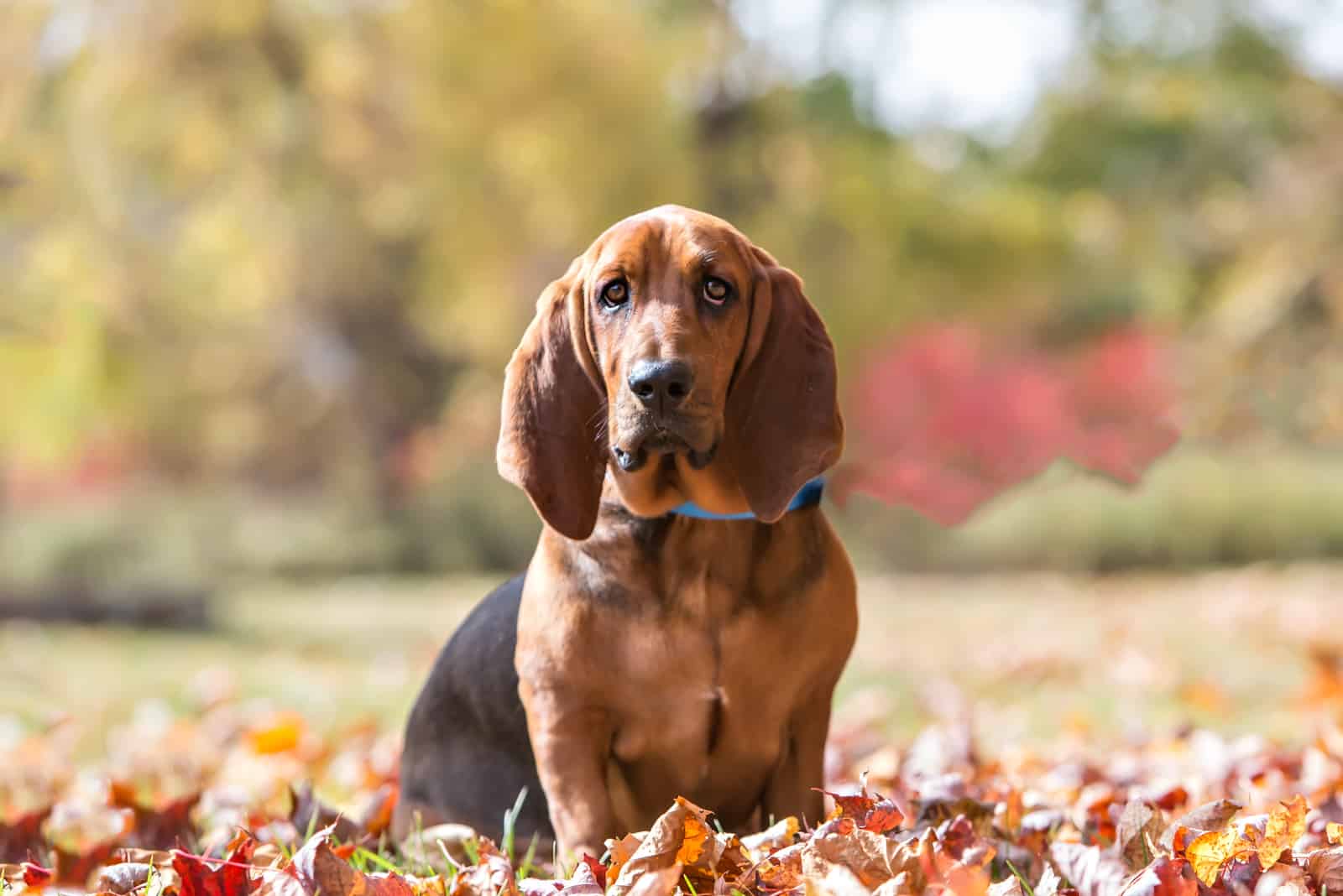
The Basset Hound growth chart is a handy tool during your pup’s early years and even later throughout his life to help you figure out whether or not he’s at a healthy weight without you having to constantly look stuff up or try and remember them on the fly.
It also serves as a good guideline to base your dog’s diet off of, a foundation on which to set his feeding regime up on and tuning it later to best fit your own elongated, floppy-eared friend.
The chart shows his ideal weight and height when he reaches physical maturity and even continues off into adulthood, plus it explains how he should be treated in the different developmental stages, his adulthood, and even his senior years in brief detail.
However, it’s not a universal fix for every single detail of his life because every dog is unique, including those of the same breed.
You’ll have to pinpoint the intricacies of your own doggo yourself, with a little bit of help from your dog’s vet who’ll help guide you and your dog throughout this process.
However, once you get the hang of the basics, you shouldn’t have too much trouble later down the line at all.
The only real issue you’ll have to tackle once he reaches physical and mental maturity are the various health issues that start popping up the older he gets.
Make sure that you’re prepared should that happen and that you know what are the appropriate steps to take when it does.
However, I firmly believe that you’d do anything to keep your doggo safe, so I have no doubt that you’ll act when you need to and do what’s best for your canine companion. Until next time.
RELATED LINKS:
- Basset Hound Feeding Chart: Resolve The Feeding Dilemma
- Miniature Basset Hound: A Full Guide To The Cutest Low-Rider
- 40 Basset Hound Mixes You Need To Know About
- 4 Most Reputable Basset Hound Breeders In Ontario
- European Vs. American Basset Hound: Are These Dogs The Same?
- Basset Hound Colors: 10+Color Combinations & Markings
